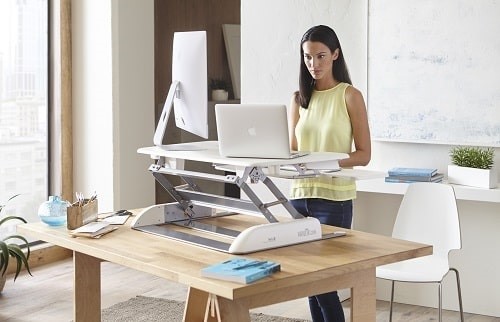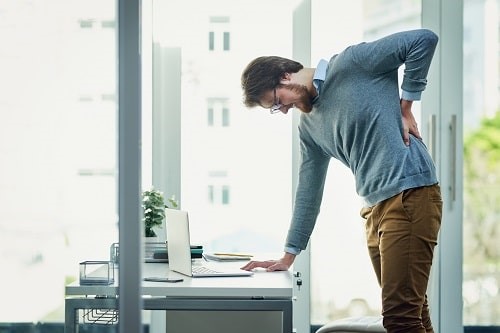The move to home working may increase the prevalence of ill health and obesity if workers spend more time sitting, so it’s essential employers encourage staff to exercise more.
Features
Get up off that thing
The UK government’s new strategy to tackle obesity was announced recently in response to findings that being overweight increases the risk from Covid-19.
There’s nothing new about these sorts of initiative, nor about the obesity ‘epidemic’ itself. Since 1975, in English speaking countries, mean body mass index (BMI) has increased in men by about 1kg/m2 per decade, and slightly more in women, although there is evidence that the trend pre-dates the 1970s by about 15–20 years. According to the government strategy, “Overconsumption of calories is one of the most significant contributing factors in becoming overweight”.
 Dr RS Bridger is a Fellow and Past President of the Chartered Institute of Ergonomics and Human Factors
Dr RS Bridger is a Fellow and Past President of the Chartered Institute of Ergonomics and Human Factors
Apart from diet, what else has changed since the 1960s? Another big change has been a reduction in physical activity in everyday life with a smaller percentage of the population engaged in extractive industries and manufacturing and a shift to service industries. Other factors include increased car ownership and a wider range of affordable labour-saving devices for use in the home.
For those working in offices before the arrival of desktop computers, few were ‘tied’ to their desks. It was essential to leave your desk to do your job to go to a filing cabinet to get files, take a handwritten letter to a typing pool and so on. ‘Sedentary behaviour’ (sitting) was interspersed with light physical activity throughout the day.
 For those working in offices before the arrival of desktop computers, few were ‘tied’ to their desks. It was essential to leave your desk to do tasks such as faxing and filing. Photograph: iStock
For those working in offices before the arrival of desktop computers, few were ‘tied’ to their desks. It was essential to leave your desk to do tasks such as faxing and filing. Photograph: iStock
One of the arguments for investment in ‘office automation’, as it was described at the time, was increased productivity because most tasks could be completed without leaving the desk. Desktop computers marked the arrival of the ‘electronic office’ and the beginning of what I call the age of ‘hyper-sedentary’ office work. Although correlation does not imply causality, it’s noteworthy that the prevalence of people being overweight and obese increased rapidly at this time.
Home working trends
Will the current trend towards increased home and hybrid working fuel the obesity epidemic or will it create more active ways of working?
Whether working at home or in the office, the long-term health risks of physical inactivity and sedentary lifestyles have been demonstrated in several large-scale epidemiological studies over the past 20 years.
Daily sitting of more than 11 hours brings increased mortality risk and is worryingly achievable in hyper-sedentary office workers, if a two-hour daily commute, eating at the table and television viewing are included. Lack of exercise and sedentary time have been shown to be independent risk factors for adverse health outcomes in several studies (so even people who exercise a lot will benefit from sitting less). Prolonged sitting is more harmful than shorter periods, even if the total time spent sitting is the same.
Recent research suggests that small amounts of moderate to vigorous physical activity (for example, a few minutes per day), appear to be six times more time efficient compared with light activity in reducing the adverse effects of a sedentary lifestyle. So, engaging in moderate to vigorous activity every day, even for short periods, is a time efficient way of obtaining long-term health benefits. However, replacing sitting with light physical activity for more than 30 minutes per day is also beneficial.
Working from home may have pros and cons for the health of office workers. The average daily commute in the UK is just under one hour each way. For those walking to and from the bus stop or train station, sitting while commuting is interspersed with light activity. Sedentary time saved not commuting may bring real health benefits for those now working from home if it’s used wisely to space periods of sedentary work with non-sedentary activities.
Home office workers can reduce their daily sitting time by, for example, going for a walk in the time they would otherwise be commuting; or by flexing the saved commuting time to engage in sports or exercise throughout the day and/or by choosing one of the ‘active workstation’ options currently available. Other home working hacks include leaving your phone away from your desk and standing when you use it.
The Center for Disease Control and Prevention (CDC) in the USA and Public Health England (PHE) recommend 150 minutes per week of moderate intensity cardio exercise plus strengthening exercises at least two days per week. Home workers would benefit by using saved commuting time to engage in brisk walking, jogging or cycling for 30 minutes, five days per week. Strengthening exercises, such as body weight squats and push-ups, can be done at home, in the park or with the aid of the many free to use fitness videos on the internet.
Unfortunately, it is likely that the aforementioned guidance will only be followed by those who already exercise. Given that about 30 per cent of the UK population never exercise at all, home working may increase the risk of ill-health and the prevalence of obesity if commuting is replaced with long periods of uninterrupted sitting at home – especially if home office workers feel under pressure to stay working at their desks (for instance, due to employer demands), or find it difficult to disconnect from the internet. One of the long-term risks of inactivity is ‘sarcopenia’ – loss of muscle mass with age. Estimates vary, but inactive people can expect to lose about one per cent of their muscle mass every year after around 25 years of age. That is why the strengthening exercises are included in the CDC/PHE guidance.
The physical demands of sitting in an office chair all day are scarcely greater than staying in bed all day. Staying in bed all day (on Earth) has been studied extensively by NASA in order to understand the effects of physical inactivity on astronauts during long space flights. The term ‘metabolic inflexibility’ describes some of these effects, which include insulin resistance (which increases the risk of developing prediabetes, and eventually, type 2 diabetes), and lowered capacity to utilise fat as an energy source. The main conclusion appears to be that physical inactivity is harmful in itself – that is, the presence of inactivity is harmful, not just the absence of exercise.
Active workstations
Calls for office work to be more active have led to the introduction of sit-stand desks, treadmill desks, pedal desks and other new products. But will their long-term use make a difference to obesity? To date, the evidence is weak, partly because it takes time to demonstrate long-term benefits.
Alternating standing with sitting in previously sedentary jobs has been shown to have beneficial effects on blood glucose control, lessening back pain in those prone to it and reducing foot swelling. However, it’s not sitting per se that’s harmful but the lack of skeletal muscle activity when sitting. All of the above increase skeletal muscle activity and increase energy expenditure. However, in order to get any work done, only ‘light’ activity is really achievable at active office workstations because strenuous activity is distracting.
 Alternating standing with sitting has been shown to have beneficial effects on blood glucose control, lessening back pain in those prone to it and reducing foot swelling. Photograph: Varidesk
Alternating standing with sitting has been shown to have beneficial effects on blood glucose control, lessening back pain in those prone to it and reducing foot swelling. Photograph: Varidesk
A recent physiological study concluded that standing at work for two hours per day (as opposed to sitting) would be unlikely to have any useful effect on reducing body fatness or in the treatment of obesity but at a national level, it might slow the rising trend in obesity. Active office work will lower other health risks by reducing the physical inactivity associated with sitting but the effects on obesity are likely to be modest, if there are any at all.
Office workers returning to the office after home working under Covid-19 restrictions and wishing to increase their daily activity levels might consider using the stairs instead of the lift, cycling to work, not eating at their desk and so on. To date, the evidence suggests that even modest increases in activity lead to increases in total energy expenditure over the day.
How can this be achieved – what can be done to tackle ‘hyper-sedentary’ office work at home and in the office?
For instance, employers can include additional information about the need for regular physical activity to boost and maintain workers’ health in their existing display screen equipment (DSE) training for both DSE assessors and users (staff).
France has introduced a law, providing a ‘right to disconnect’ (to disconnect outside of working hours to enjoy free time without disturbance, unless in emergencies or on-call). Other European parliaments are likely to follow. The UK has no such law. Currently, employers are bound by working time and health and safety rules and the debate about the right to disconnect is under way.
There are two good reasons why some countries have introduced these laws. The right to disconnect entrenches uninterrupted free time which can be used for exercise or for light to moderately demanding domestic activities. Light intensity steady state exercise (known as LISS) is effective in inducing the use of fat as an energy source but has to be engaged in without interruption for 30 minutes to one hour.
Psychological stress is outside the scope of this article, except to note that chronic anxiety caused by high workloads and a lack of control has metabolic effects, including chronic inflammation, which is involved in the development of many chronic conditions. Psychological stress can therefore exacerbate the health hazards of physical inactivity. The right to disconnect gives employees more control over their working lives and may improve work-life balance (a lack of work-life balance is known to be a significant cause of occupational stress).
For much of the 20th century, employers attempted to standardise working conditions to maximise efficiency. Flexible work arrangements for office workers have been an option for many years and there are arguments that it should be the default for home workers – not just for health reasons (to allow them to break up periods of sitting into shorter periods interspersed with other activities), but to counter the feeling that one is ‘living at work’ rather than working from home.
Employers should also consider the domestic circumstances of their home workers (which are far from standardised) and fund reasonable adjustments where needed (for example, to ensure that home office workspaces comply with the DSE Regulations and the minimum space requirements for desk-based office work).
Taking an ergonomic approach
How are more active ways of working going to be achieved in practice? There are many options for active workstations nowadays, so how do we choose between them?
From the perspective of ergonomics, it’s a matter of balancing the requirements of the task against the need to increase energy expenditure and the available active workstation options.
For example, for ‘eyes busy, hands busy’ tasks requiring concentration for long periods, a standing desk is not the best option. My own research demonstrated that standing still to work at a computer is very uncomfortable after about 20 minutes. Standing still is unhealthy and uncomfortable and poses an increased long-term risk of varicose veins and hip and knee problems. Standing desks are fine for short periods of work not requiring concentration.
A standing desk combined with a ‘perch stool’ is a better option, as is a pedal desk. A standing desk with a perch stool enables employees to alternate standing with semi-standing instead of standing still all the time. A pedal desk, which incorporates an exercise bike, increases energy expenditure while working and improves circulation in the legs.
 It’s not sitting per se that’s harmful but the lack of skeletal muscle activity when sitting. Photograph: iStock
It’s not sitting per se that’s harmful but the lack of skeletal muscle activity when sitting. Photograph: iStock
For tasks requiring extensive use of the phone, treadmill desks – which incorporate a treadmill for exercise – are an option. For tasks involving the manipulation of physical objects, such as reports, photocopies and books, standing desks are a good option. There are also gadgets such
as ‘foot-fidget’ devices (bouncy footrests) which, while not increasing energy expenditure very much, do have metabolic and other benefits.
The Chartered Institute of Ergonomics and Human Factors provides free guidance on home office ergonomics, which can be passed on to staff. Seated home office workers should take a break from sitting every 20–30 minutes.
Prior to the industrial revolution, most people worked at home or close to their homes. As home and hybrid working become the ‘new normal’ they bring both opportunities and challenges. There is an opportunity to improve the health of the workforce by reducing sedentary behaviour and there are challenges – the inability to disconnect may exacerbate the hyper-sedentary lifestyles of home workers with a concomitant increase in obesity.
Dr RS Bridger is a Fellow and Past President of the Chartered Institute of Ergonomics and Human Factors. He is author of A Guide to Active Working in the Modern Office, and Introduction to Human Factors and Ergonomics.
FEATURES

Sedentary working and how to combat the ‘sitting disease’
By Gavin Bradley, Active Working on 05 April 2024
Prolonged and excessive sitting poses a major risk to our health, but the Get Britain Standing campaign and On Your Feet Britain Day on 25 April are a great way of encouraging workers to sit less and move more.

Company culture and wellbeing: a crucial link
By Bex Moorhouse, Invigorate Spaces on 05 April 2024
Investing in measures to support worker wellbeing will be ineffective unless the company culture genuinely incorporates values like teamwork, involvement, flexibility and innovation.

Office design and culture: happier and healthier staff – or the opposite?
By Guy Osmond, Osmond Ergonomics on 03 April 2024
Applying ergonomic principles to workstation set-ups and ensuring the physical environment supports neurodivergent people are just some of the ways of creating an office where everyone can thrive, but a supportive and positive organisational culture is vital too.


